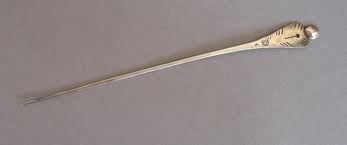SARONNO, Italy – Up until the end of the 19th century, there was a tradition here in Lombardia that called for giving a girl child a gift of a silver sperada when she was born.
 |
| A Silver Sperada |
A sperada, also known as a raggiare, is a long, thin needle like hairpin, about eight inches in length, with a decorated top and bottom (olivelle), that was used as a hair ornament. Over the course of her life, her parents, relatives, and then her husband, would add to her sperada collection. For special occasions she would wear the sperada in her hair. They were held in a halo-like semi-circle, by a wooden frame and tied with a black ribbon called a ‘fettucine nero’, or spighetta de cutun negher in local dialect.
Sperade are one of the oldest ‘hair accessories’ in Italy. Those dating back to the Bronze Age are called ‘spilloni’, pins, but those found in the graves of the ancient Romans are known as ‘hasta caelibaris’, or ‘aghi crinali’.
 |
| A Complete Sperada |
The more expensive sperada were made by silversmiths. Using all the techniques necessary to make fine jewelry, the silversmith would work the olivelle into miniature pieces of art. These highly decorated sperada were worn by the women of Lombardia with the same pride as they wear diamonds and furs today. Sperada have long been a source of pride in Lombardia, witnessed by this description of Lucia Mondella, the protagonist of ‘I Promessi Sposi’ (The Betrothed), the 19th century masterpiece by Italian writer Alessandro Manzoni.
‘Lucia had just come forth adorned from head to food by the hands of her mother. Her friends were stealing glances at the bride, and forcing her to show herself, while she, with the somewhat warlike modesty of a rustic, was endeavoring to escape, using her arms as a shield for her face, and holding her head downwards, her black penciled eyebrows seeming to frown, while her lips were smiling. Her dark and luxuriant hair, divided on her forehead with a white and narrow parting, was united behind in many – circled plaitings (braids), pierced with long silver pins, disposed around so as to look like a halo or saintly glory, a fashion still in use among Milanese peasant girls.”
 |
| Lucia Wearing Her Sperada |
From the moment a girl became engaged, it was expected that, as a sign of his love, her husband-to-be would give her a gift of sperada equal to her age. During her lifetime, a woman would be gifted with up to 45 to 47 sperada.
For those families who could not afford to buy sperada of high grade silver, they were also made in less noble metals, but valued nonetheless.
 |
| A Complicated Affair |
You won’t find hand-worked silver sperada for sale these days. The much coveted surviving pieces are treasured and held by families or museums.
THURSDAY PREVIEW: Auntie Pasta's Semola Battuta, a Pugliese recipe that will surprise you.















